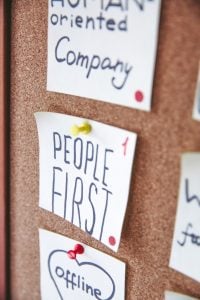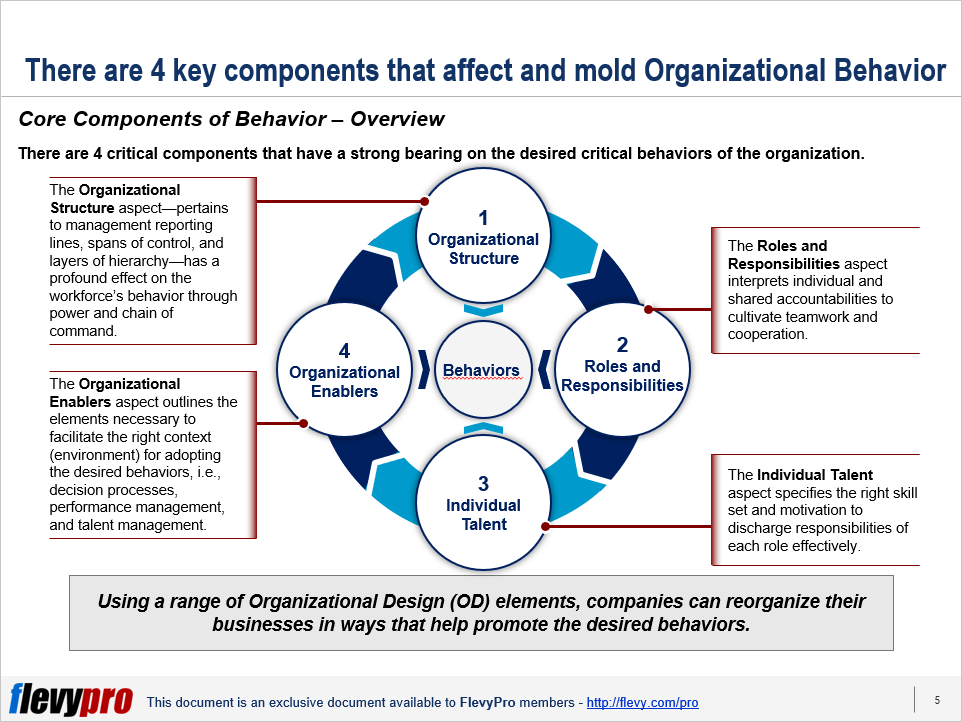Editor's Note: Take a look at our featured best practice, Smart Organizational Design (27-slide PowerPoint presentation). Business environment has transformed drastically and has become immensely challenging due to competition, disruptive technologies, laws, and globalization. These challenges warrant better performance to address customer needs and to survive--and outpace--intense competition.
Consequently, [read more]
Also, if you are interested in becoming an expert on Organizational Design (OD), take a look at Flevy's Organizational Design (OD) Frameworks offering here. This is a curated collection of best practice frameworks based on the thought leadership of leading consulting firms, academics, and recognized subject matter experts. By learning and applying these concepts, you can you stay ahead of the curve. Full details here.
* * * *
 Inculcating productive workforce behaviors is of utmost significance in Business Transformation, successful Strategy Execution, and Performance Improvement. However, making people embrace productive behaviors involves a concerted effort across the organization.
Inculcating productive workforce behaviors is of utmost significance in Business Transformation, successful Strategy Execution, and Performance Improvement. However, making people embrace productive behaviors involves a concerted effort across the organization.
The realization of Transformation, Strategy, and Performance improvement goals can become a reality by developing a thorough understanding of the 4 components of Organizational Behavior. These components act as powerful levers in shaping the desired behaviors in the workforce:
- Organizational Structure
- Roles and Responsibilities
- Individual Talent
- Organizational Enablers

These Organizational Design levers work effectively when combined and aligned. Let’s discuss the first 2 levers in detail now.
Organizational Structure
Organizational Structure represents the management reporting lines that create the organization’s spans of control, layers, and number of resources. Organizational Structure is a foundational driver to Organizational Design, which also has a strong positive bearing on promoting the behaviors critical to improve the overall performance of the enterprise. This is owing to the power that a position exerts on the subordinates based on factors that are important for individuals—e.g., work, compensation, and career ladder.
The Organizational Structure indicates an enterprise’s priorities. An organization is typically structured in accordance with its top most priority. For instance, functional organizational structure is adopted by enterprises having functional excellence as a priority. In present-day’s competitive markets, most organizations have to deal with several priorities at a given time, which could be conflicting. However, this does not mean adding new structures on top of existing ones, thereby increasing unnecessary complexity. Creating overly complex structures to manage multiple priorities results in red tape and delayed decisions. All roles are interdependent, necessitating cooperation. This means taking care of the needs of others—instead of just watching over personal priorities—and encouraging individual behaviors that boost the efficiency of groups to achieve collective objectives.
Roles & Responsibilities
Roles and responsibilities deal with tasks allocated to each position and individual. Organizational Design depends heavily on redefining clearer and compelling roles and responsibilities—to avoid any duplication of efforts or creating adversaries among team members. In a collaborative culture where cooperation is the mainstay of an organization, individuals should not only be aware of what is required of them, but also appreciate the responsibilities of their team members, the authorities their roles exercise, the skills required, and the metrics to measure success.
A methodical way to outline roles and responsibilities effectively—while minimizing complexity—that encourages cooperation and empowerment is through the “Role Chartering” technique. The technique requires distinctly identifying all roles on the basis of 6 key factors:
- Describing shared and individual accountabilities
- Outlining indicators to track success
- Specifying who has the right to decide what
- Indicating the capabilities critical for roles
- Assigning the leadership traits valuable for the roles
- Charting the abilities required for accomplishing personal and team goals.
Interested in learning more about these components to Organizational Behavior? You can download an editable PowerPoint on Organizational Behaviors here on the Flevy documents marketplace.
Do You Find Value in This Framework?
You can download in-depth presentations on this and hundreds of similar business frameworks from the FlevyPro Library. FlevyPro is trusted and utilized by 1000s of management consultants and corporate executives. Here’s what some have to say:
“My FlevyPro subscription provides me with the most popular frameworks and decks in demand in today’s market. They not only augment my existing consulting and coaching offerings and delivery, but also keep me abreast of the latest trends, inspire new products and service offerings for my practice, and educate me in a fraction of the time and money of other solutions. I strongly recommend FlevyPro to any consultant serious about success.”
– Bill Branson, Founder at Strategic Business Architects
“As a niche strategic consulting firm, Flevy and FlevyPro frameworks and documents are an on-going reference to help us structure our findings and recommendations to our clients as well as improve their clarity, strength, and visual power. For us, it is an invaluable resource to increase our impact and value.”
– David Coloma, Consulting Area Manager at Cynertia Consulting
“As a small business owner, the resource material available from FlevyPro has proven to be invaluable. The ability to search for material on demand based our project events and client requirements was great for me and proved very beneficial to my clients. Importantly, being able to easily edit and tailor the material for specific purposes helped us to make presentations, knowledge sharing, and toolkit development, which formed part of the overall program collateral. While FlevyPro contains resource material that any consultancy, project or delivery firm must have, it is an essential part of a small firm or independent consultant’s toolbox.”
– Michael Duff, Managing Director at Change Strategy (UK)
“FlevyPro has been a brilliant resource for me, as an independent growth consultant, to access a vast knowledge bank of presentations to support my work with clients. In terms of RoI, the value I received from the very first presentation I downloaded paid for my subscription many times over! The quality of the decks available allows me to punch way above my weight – it’s like having the resources of a Big 4 consultancy at your fingertips at a microscopic fraction of the overhead.”
– Roderick Cameron, Founding Partner at SGFE Ltd
“Several times a month, I browse FlevyPro for presentations relevant to the job challenge I have (I am a consultant). When the subject requires it, I explore further and buy from the Flevy Marketplace. On all occasions, I read them, analyze them. I take the most relevant and applicable ideas for my work; and, of course, all this translates to my and my clients’ benefits.”
– Omar Hernán Montes Parra, CEO at Quantum SFE

229-slide PowerPoint presentation
Curated by McKinsey-trained Executives
Unlock Success with the Ultimate Organizational Behavior and Design Business Toolkit: A Comprehensive 220+ Slide PowerPoint Deck
In the dynamic landscape of modern business, success hinges not only on strategic planning and financial acumen but also on
[read more]
Want to Achieve Excellence in Organizational Design (OD)?
Gain the knowledge and develop the expertise to become an expert in Organizational Design (OD). Our frameworks are based on the thought leadership of leading consulting firms, academics, and recognized subject matter experts. Click here for full details.
Organizational Design (AKA Organizational Re-design) involves the creation of roles, processes, and structures to ensure that the organization's goals can be realized. Organizational Design span across various levels of the organization. It includes:
1. The overall organizational "architecture" (e.g. decentralized vs. centralized model).
2. The design of business areas and business units within a larger organization.
3. The design of departments and other sub-units within a business unit.
4. The design of individual roles.
In the current Digital Age, there is an accelerating pace of strategic change driven by the disruption of industries. As a result, to remain competitive, Organizational Design efforts are becoming more frequent and pervasive—with the majority of organizations having experienced redesign within the past 3 years. This has only been exacerbated by COVID-19.
Frustratingly, only less than a quarter of these Organizational Design efforts are successful. Most organizations lack the best practice know-how to guide them through these Transformations effectively.
Learn about our Organizational Design (OD) Best Practice Frameworks here.
Readers of This Article Are Interested in These Resources

30-slide PowerPoint presentation
The most resilient and consistently successful organizations have discovered that the devil is in the details. No company may ever totally master the enigma of execution. However, organizing to execute has truly become a source of Competitive Advantage.
Execution only becomes effective when the
[read more]

22-slide PowerPoint presentation
Transformation initiatives are typically undertaken to solve a pressing issue, improve performance, or to serve customers better. These initiatives necessitate changing the existing behaviors of the employees across the organization. However, this isn't a straightforward task.
Ingrained
[read more]

22-slide PowerPoint presentation
What is Behavioral Strategy?
First, to understand Behavioral Strategy, we must first examine the concept of Cognitive Biases. There are 2 different types of biases in people that cause them to stray from rational decision making: cognitive and emotional. Cognitive biases arise due to
[read more]

21-slide PowerPoint presentation
This presentation provides a detailed understanding of the 4 Organizational Design (OD) elements that act as building blocks for yielding the desired behaviors in the workforce:
1. Organizational Structure
Organizational Structure represents the management reporting lines that create the
[read more]
 Inculcating productive workforce behaviors is of utmost significance in
Inculcating productive workforce behaviors is of utmost significance in 




